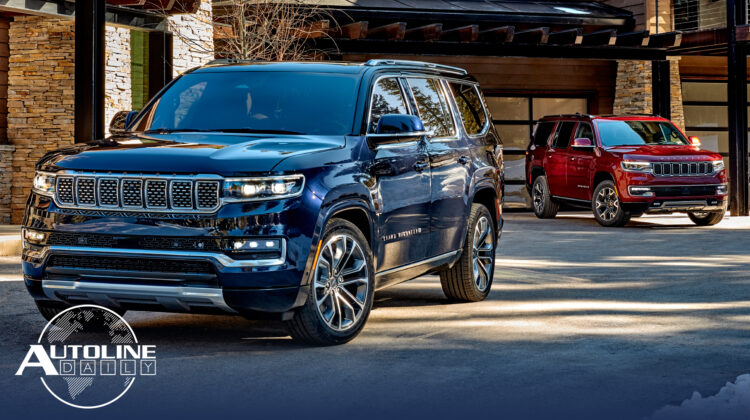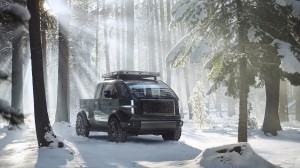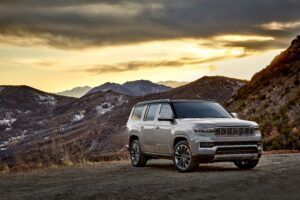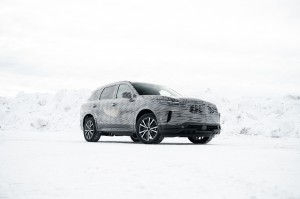

Follow us on social media:
Runtime: 12:10
0:07 Canoo Shows Off EV Pickup Concept
1:27 Jeep Reveals New Wagoneer & Grand Wagoneer
3:42 Incentives Drive Down Toyota Mirai Price
5:42 Dongfeng Adopts Multi-Supplier L2 System
6:40 Infiniti Details New QX60 AWD System
8:33 Tesla Has the Lowest Battery Costs
9:33 What’s With All the Logo Changes?
10:17 The Story Behind Our Regular Screwdriver Question
Visit our sponsors to thank them for their support of Autoline Daily: Bridgestone, Intrepid Control Systems and Magna.
This is Autoline Daily, the show dedicated to enthusiasts of the global automotive industry.
CANOO THROWS HAT IN EV PICKUP GAME
The electric pickup segment is already jam packed and now it’s getting even more crowded. EV startup Canoo unveiled a small cab-forward truck based on its EV platform. As you can see, it looks similar to its pod-like vehicle its already revealed, except with a bed on the back. It’s available with dual motors or a single motor in the rear and it cranks out 600 horsepower and 550 lb.ft. of torque with the dual motors. It has a payload capacity of 1,800 pounds and over 200 miles of range. But the company didn’t reveal what test cycle that’s based on or the size of the battery. But this pickup is pretty versatile. The six-foot long bed features a pull-out extender that adds an extra two feet of length. The sides of the bed also have fold-down tables built into it. The sides feature a hidden step for easier access to the bed. And the bed comes with dividers, to help keep items separated. It has a front cargo storage area, that includes a fold down work table with electrical outlets. And the truck can be converted into a camper. Canoo will begin taking pre-orders for the pickup in the second quarter of the year but deliveries won’t start until early 2023.
JEEP REVEALS ALL-NEW WAGONEER & GRAND WAGONEER
Jeep is finally providing details about the all-new Wagoneer and Grand Wagoneer, which start getting delivered in the 2nd half of this year. The full-size SUVs ride on a heavily modified version of the Ram 1500 chassis and includes changes like a fully independent rear suspension. Both vehicles are the same size, but there’s some minor styling cues and a lot of content differences that set them apart. We think the biggest visual cue is the treatment of the hood, just above the grille. On the Grand Wagoneer it kind of tucks under a bit, which hides the lettering of the vehicle name. But you’ll notice other differences in the grille, lighting accents and even the wheel designs. Under the hood, the Wagoneer comes standard with a 5.7L V8 with 48-volt tech that produces over 390 horsepower and is mated to an 8-speed. The Grand Wagoneer also features an 8-speed auto, but is powered by a 471 horsepower 6.4L V8. When properly equipped either setup can tow up to 10,000 pounds. Now let’s move to the interior, where you really get to see the luxuriousness of these vehicles shine through, especially the Grand Wagoneer. Highlights include real Walnut wood, aluminum and fine leather accents and coverings. To make sure that no one gets bored inside the vehicle, there’s up to 75 inches of total screen area, which even includes a 10.25 inch display just for the passenger. Ok, price time. The Wagoneer starts out at just below $60-grand, including destination, while the Grand Wagoneer starts at about $89,000, but it’s easy to push that price tag well over $100-grand. Jeep has been moving more upscale for a while now, but I can’t wait to see how people react to that kind of price from the brand. Will it be like reactions to the $60,000 Kia K900? Let us know what you think.
TOYOTA MIRAI INCENTIVES DRIVE PRICE WAY DOWN
Let’s stick with pricing for a moment because it’s possible to get a Toyota Mirai right now for well under $20-grand. Sounds too good to be true, but here’s how it works out. The base XLE trim starts at $50,495, including destination charges. But from now until the end of March, Toyota is offering a $20,000 incentive for anyone that uses Toyota Financing, which includes zero interest for up to 72 months. That only gets us part of the way. The federal tax credit for a fuel cell is up to $8,000, while California is also giving out another $4,500 bucks. That brings the price of the XLE to $17,995. And if that wasn’t enough, Toyota gives out a three year $15,000 fuel credit as well. So, what’s the catch? There’s two. This only applies to the U.S. and the Mirai is only sold in California.
We’ve got a great Autoline After Hours coming up this afternoon with Mike O’Brien who used to run product planning in North America for Toyota and Hyundai. So how do automakers actually go about figuring out which segments they need to be in? We’re going to take you inside the product development process. So join John and Gary for an insider’s view of how automakers think.
DONGFENG ADOPTS MULTI-SUPPLIER L2 SYSTEM
In China Dongfeng is coming out with a pretty good Level 2 system that was developed by ZF, working together with Mobileye and Hella. Mobileye supplies the camera system, while Hella makes the short range radar, and ZF does everything else. The system provides a 360 degree view of what’s going on around the car. And that, in turn, allows for functions such as adaptive cruise control with automated lane changes, traffic jam assist, traffic sign recognition and automated garage parking. Importantly, the system meets the EU’s NCAP goals for 2025. ZF calls it coAssist L2+, and claims it’s the most affordable L2 system available. We believe it. It’s going on the Dongfeng Aeolus Yixuan, a compact sedan that sells for under $15,000.
INFINITI DETAILS NEW QX60 AWD SYSTEM
We usually don’t report on teaser images that automakers dribble out one after the other, because all they’re trying to do is use the media to give them more coverage. But Infiniti put out this video of a camouflaged QX60 with a reasonable amount of information about its all-wheel drive system. Instead of using electromagnetic coupling to engage the rear wheels, it uses sensors to predict when to engage the rear axle. Electromagnetic coupling requires the wheels to slip before it engages. And while that happens really fast, Infiniti’s predictive system provides instant response. By monitoring road conditions, it can engage all-wheel-drive before it’s needed. And it can direct 50% of the power to the rear. But the system also uses the brakes for side-to-side torque vectoring. The best we’ve driven so far is Magna’s e4 system, which eliminates the mechanical differential and uses electric motors. And that gives you instant torque vectoring.
TESLA HAS THE LOWEST BATTERY COSTS
Tesla is the leader in EVs and here’s another area where it has a leg up on its competition. According to a new report from Cairn Energy Research Advisors, Tesla pays an average of $142 per kWh for battery cells purchased from its three suppliers; LG Chem, Panasonic and CATL. By comparison, GM pays $169 per kWh, while the industry average is $186 per kWh. Cairn also estimates that Tesla’s battery packs cost an average of $187 per kWh. GM’s cost $207 per kWh, while the industry average is $246 per kWh. Cairn says Tesla will remain the leader through 2030 but it also predicts that GM will close that gap and get close in price with Tesla by the end of the decade.
WHAT’S WITH ALL THE LOGO CHANGES?
All of a sudden automakers all around the world seem to have decided it was time to get a new logo. Cadillac redesigned its logo as it goes all electric. And then General Motors decided it needed a change, too. Peugeot changed its logo last week, so Renault changed its logo this week. Kia came up with a new one, so did Volkswagen, and BMW decided it had to jump on the bandwagon. And just for good measure, Opel and Vauxhaul decided it was time for an update. All automotive logos evolve over time, but it’s amazing to see how many automakers have changed their logos over the last year or so.
YOUNGER PEOPLE DON’T KNOW WHAT A REGULAR SCREWDRIVER IS
Here’s the story behind yesterday’s screwdriver question. Lambo2015 wrote to say he “was replacing my transmission filter/fluid and as with most new cars the fluid fill is a rubber plug on the side of the transmission only accessible from under the car. I was getting some assistance from a young man in his early 20s. I asked him for a regular screwdriver so I could remove the plug. Granted I know the proper term should be either flathead or Phillips, but I was raised that a flat head was standard or regular, so I have a bad habit of just calling it a regular. He brought me a Phillips.” Lambo says this started a debate with family and friends. The end result? He found that most everyone under 30 years old said Phillips or asked what is a regular? Those over 30 mostly said flathead is a regular. I’ll say I had not heard of a flathead being called a regular and probably would have asked. Lambo finishes with “In the end I realized I’m old. Something I thought was common knowledge is apparently very confusing to others.” Well, not to our viewers. We were blown away by all the responses and people overwhelmingly said flathead.
But that’s a wrap for today. Thanks for watching
Thanks to our partner for embedding Autoline Daily on its website: WardsAuto.com

John McElroy is an influential thought leader in the automotive industry. He is a journalist, lecturer, commentator and entrepreneur. He created “Autoline Daily,” the first industry webcast of industry news and analysis.










